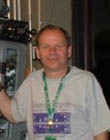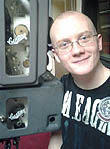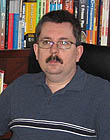|
|
 
|
|
Author
|
Topic: Sharpness Degradation
|
|
|
|
|
|
|
Jim Cassedy
Phenomenal Film Handler

Posts: 1661
From: San Francisco, CA
Registered: Dec 2006
|
 posted 12-28-2017 09:49 AM
posted 12-28-2017 09:49 AM




While, as Carsten says, internal dust can be a factor, my personal
experience with the machines I work with is simply "drift" from due
to the limited mechanical tolerances of the focus mechanism gears
& servos. Those systems are pretty good, but in reality each time
a format/focus change is done, the lens gears don't wind up 100%
exactly where they should be. The error is very small, but over a
period of time those tiny position errors add up to enough to the
point where it starts becoming noticeable on screen as soft focus.
I work with several NEC projectors, and I've found that with the
usage pattern they get, I have to check and touch-up the lens
macros about every 2-3 months. Even if they "look ok" on screen,
I've noticed they benefit from a bit of adjusting, which becomes
most obvious if you've got a good focus/resolution chart to use.
. . and as Carsten says, an occasional professional projector
cleaning will also help insure you're getting clean & clear images.
| IP: Logged
|
|
Leo Enticknap
Film God

Posts: 7474
From: Loma Linda, CA
Registered: Jul 2000
|
 posted 12-28-2017 05:35 PM
posted 12-28-2017 05:35 PM





99% of my operating and servicing experience on digital projectors is with Barco and NEC, and I would agree with Jim that NECs are worse for focus drift.
However, for any make of digital projector, I would recommend that monthly (if the theater has someone on site who is capable of doing this), or at every planned maintenance call if not, the following is done:
- Remove the lens from the projector, clean the glass element at both ends, and lubricate the gears of the focusing mechanism, then reinstall.
- Perform home and return (Barco)
- Hook a wifi access point to the management network (if you don't have permanent wifi access installed), then go down into the house with your laptop, stand right next to the screen (as in, 2-3 feet from it), then for each lens file, project a test pattern, adjust the focus until you can see the individual pixels, then save it.
Check for focus uniformity (Scheimpflug), too, though obviously, this can't be adjusted remotely. A pair of binoculars comes in very handy for this.
| IP: Logged
|
|
|
|
|
|
|
|
Leo Enticknap
Film God

Posts: 7474
From: Loma Linda, CA
Registered: Jul 2000
|
 posted 12-29-2017 10:09 AM
posted 12-29-2017 10:09 AM





In my admittedly very limited time as a service tech, I've never come across a projector in which the convergence has drifted, unless it's just been shipped (in other words, a new installation), or the light engine has been pulled and reseated (or replaced). Even then, not always. I replaced a light engine in a DP2K-32B last month. The "new" light engine was actually a used one we had in stock, that had been pulled from a projector that had been totaled and parted out for an unrelated reason (water damage, if I remember correctly). After the light engine swap was done, the back focus and focus uniformity both had to be reset, but the convergence was perfect: all the pixels looked perfectly aligned, even standing right next to the screen.
One thing they didn't teach me in Barco school is that the adjustments that need you to touch the projector to do - back focus, focus uniformity and convergence - are a darn sight easier when the projector is projecting onto a whiteboard 15 feet away in a classroom, than a screen 50 feet away in a theater. A telescope or a pair of binoculars (doesn't need to be fancy or expensive) is an essential toolkit item for any job that could require adjustments to the optical system.
| IP: Logged
|
|
|
|
|
|
|
|
|
|
|
|
Steve Guttag
We forgot the crackers Gromit!!!

Posts: 12814
From: Annapolis, MD
Registered: Dec 1999
|
 posted 12-29-2017 02:24 PM
posted 12-29-2017 02:24 PM




I find most binoculars to be difficult on convergence and cheap ones near worthless. Cheap ones have enough chromatic aberrations that you tend to compensate for the poor lens. I'm a proponent of the USL/QSC VCC-102. Sure, I've used Binos or spotting scopes for quick adjustments but for serious work, particularly on NEC or anyone's Series 1 projectors, the VCC-102 is the right tool for the job.
We have made a tripod adapter for our Binoculars. Takes one thing out of your hand and holds it steady. Handy for bore-sighting/Scheimpflugging. Use the right pattern too. Barco got that right and much better than the rest. Use an All-green pattern with many targets...it isn't at either extreme of the wavelengths and the pattern is easy to see, even 4K.
Though no longer made (unfortunately), the PSA200 was THE tool for adjusting a cold mirror (looking for even light distribution).
Other handy tools are LONG tools. Some convergence systems require very long and small allens (and insulate them), NEC, for no good reason, doesn't include cap screws on their NC1200/NC2000 prisms to hold the settings so you need to have their adjusters BEFORE you unlock anything. Christie tends to make you want long screwdrivers and short ones. They often, now have the allens you need tucked away in the machine but don't count on them being there (not all came with them).
| IP: Logged
|
|
|
|
All times are Central (GMT -6:00)
|
|
Powered by Infopop Corporation
UBB.classicTM
6.3.1.2
The Film-Tech Forums are designed for various members related to the cinema industry to express their opinions, viewpoints and testimonials on various products, services and events based upon speculation, personal knowledge and factual information through use, therefore all views represented here allow no liability upon the publishers of this web site and the owners of said views assume no liability for any ill will resulting from these postings. The posts made here are for educational as well as entertainment purposes and as such anyone viewing this portion of the website must accept these views as statements of the author of that opinion
and agrees to release the authors from any and all liability.
|

 Home
Home
 Products
Products
 Store
Store
 Forum
Forum
 Warehouse
Warehouse
 Contact Us
Contact Us




 Printer-friendly view of this topic
Printer-friendly view of this topic















